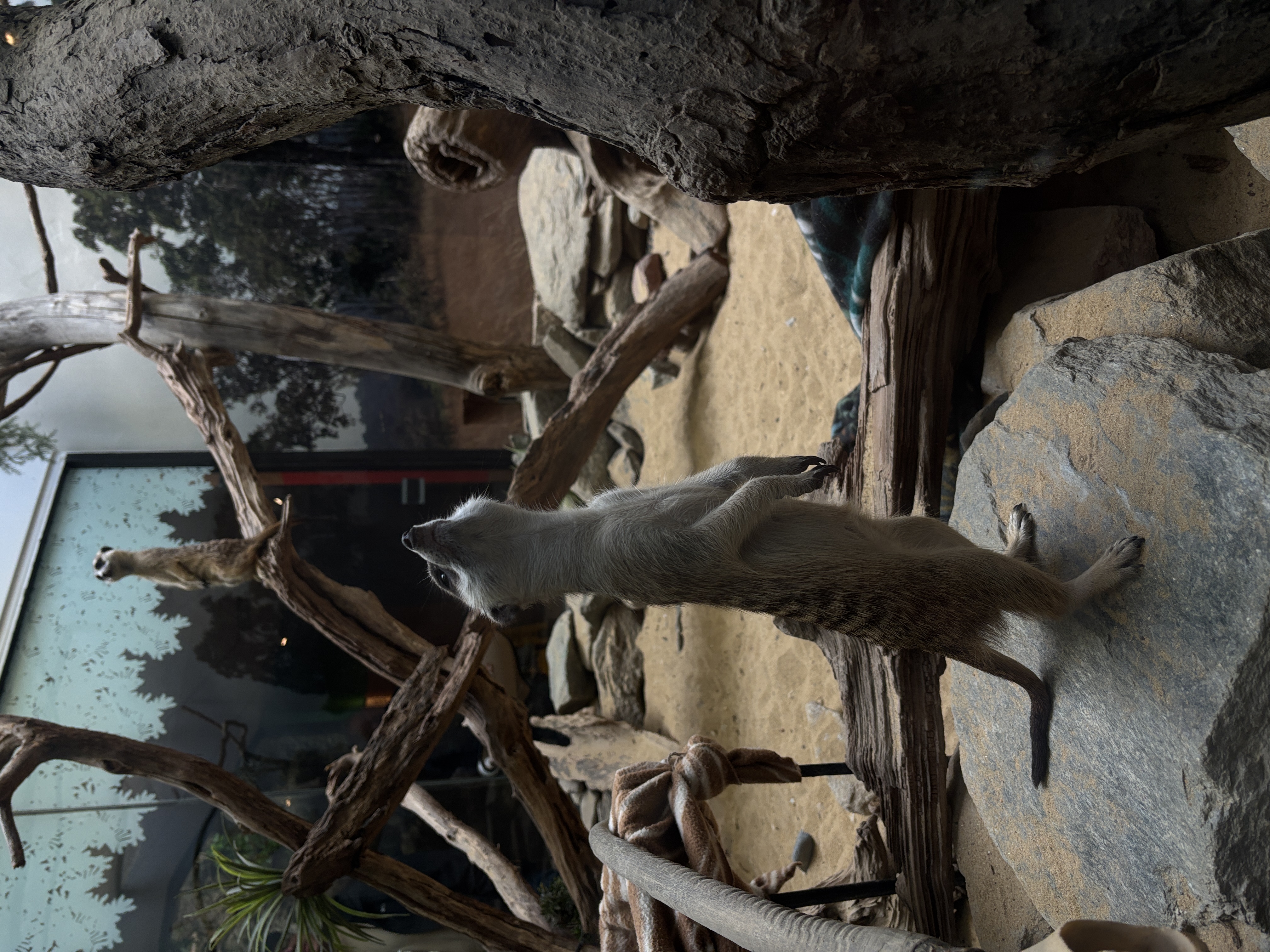Excursion to The National Zoo
May 4, Washington DC
Zoos serve as important centers of learning and conservation, offering visistors the opportunitity to learn about the importance of various species and their ecosystems. It allows many to engage in a side of the nature, outside of urban and suburban areas, that they otherwise wouldn't have been able to see. during a visit to the Small Mammal House and and Amazonia exhibits, I was able to observe how information is presented in an accessible way, offering varying levels of depth for different visitors, and the ways that zoos ehance public understanding of animals and their habitats. Additionally, it was important to note the efforts made by the zoo to address the mental and emotional welfare of its animals.

Meerkat located in the Small Mammals Hall
In the Small Mammal House, each species' display includes information about its origin, how they are adapted to their environment, its diet, and its habitat. Some of the species featured are the Northern Treeshew, Golden-headed Lion Tamarin, Fennec Fox, and Screaming Hairy Armadillo. Beyong basic identification plaques, the exhibit also includes X-rays of limbs and skeletons, as well as skull displays. These additional elements provide deeper insight into the animals’ anatomy. The educational level of this exhibit appears to be mixed as some signs are simple and accessible to younger visitors, but the skeletal displays are positioned at a height better suited for older guests. Despite these features, many visitors did not stop to read the information plaques or examine the interactive displays.

Arapaima found in the Amazonia Hall
The Amazonia exhibit also provides details about each species’ origin, diet, and habitat. Some notable animals on display include stingrays, arapaima, poison dart frogs, and piranhas. Rather than relying solely on text panels, this exhibit immerses visitors in a walkthrough environment that recreates the Amazon rainforest, complete with recreations of trees and various flora and fauna you could find in that environment. I have always found it to be the most engaging area within the Zoo as it gives guests the opportunity to put themselves in the environment, surrounded by the humid air and earthy smell of the actual Amazon. The educational content varies, allowing visitors to either enjoy the sensory experience or engage with more detailed descriptions. However, like in the Small Mammal House, few guests were seen reading the informational plaques.
The zoo did well in enhancing public understanding of animals and ecosystems, going beyond just descriptions on signs. One example is the design of enclosures to mimic natural habitats, such as using sand and pine trees for certain snakes or replicating the environments where specific geckos would live in the wild- places like sheds, amongst toolboxes and brooms. Another method is the use of immersive exhibits, like the Amazonia walkthrough, which allows visitors to experience a simulated version of the rainforest ecosystem. These approaches help guests better understand the animals' natural behaviors and ecological roles.
Modern zoos prioritize the mental and emotional well-being of their animals. One example of this is the inclusion of climbing structures, such as ropes for great apes, allowing them to engage in natural behaviors. Another is the use of enrichment activities, like providing orangutans with bubble-blowing activties to stimulate their minds. Additionally, animals are housed in environments that resemble their native habitats. This includes fish being placed in tanks with species they would naturally coexist with, as seen in the Amazonia exhibit. These efforts help reduce stress and promote healthier, more natural behaviors in captive animals.
The zoo serves as both an educational experience and a sanctuary for animals, where the public can learn about different animals without worrying about poor treatment. Through immersive exhibits, habitat-appropriate enclosures, and enrichment activities, it creates a deeper understanding of wildlife. However, the lack of visitor engagement with informational displays suggests that more interactive or attention-grabbing methods could further enhance the educational experience.


